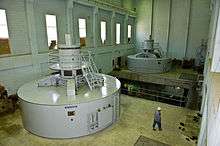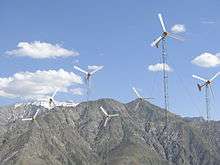Energy in Afghanistan
Energy in Afghanistan is primarily provided by hydropower. According to the World Bank, approximately 84.1% of Afghanistan's population has access to electricity.[1] Some rural areas, however, may not get 24-hour electricity but this will change once the major CASA-1000 project is completed in 2020.[2]

According to Da Afghanistan Breshna Sherkat (DABS), Afghanistan generates around 300 megawatts (MW) of electricity mainly from hydropower followed by fossil fuel and solar. About 1,000 MW more is imported from neighboring Uzbekistan, Tajikistan, Iran and Turkmenistan.[2]
Due to the large influx of expats from neighboring Pakistan and Iran, Afghanistan may require as much as 7,000 MW of electricity in the coming years.[3] The Afghan National Development Strategy has identified alternative energy, such as wind and solar energy, as a high value power source to develop.[4][5] As a result, a number of solar and wind farms have been established,[6][7] with more currently under development.[8][9][10][11][12][13]
Hydroelectricity

Afghanistan has the potential to produce over 23,000 MW of hydroelectricity.[4][14][15] A number of hydroelectric plants were built between the 1950s and the mid-1970s, which included the Naghlu in the Sarobi District of Kabul Province and the Kajaki in Helmand Province. Other hydroelectric facilities that were operational as of 2002 included plants at Puli Khumri, Darunta in Nangarhar Province, and one in Mazar-i-Sharif. Also in operation was the Breshna-Kot Dam in Nangarhar, which had a generating capacity of 11.5 MW. Construction of two more power stations, with a combined capacity of 600 kW, was planned in the city of Charikar in Parwan Province.
Southern Afghanistan has been lacking adequate electricity due to problems with the Kajaki power plant in Helmand, which has been damaged and neglected for many years.[16] A third generating turbine was recently added. This added 16.5 MW to its generating capacity and eventually provide the southern Afghan cities of Kandahar and Lashkar Gah with around 10-hour electricity per day. The Afghan-India Friendship Dam in Herat Province, which produces 42 MW of electricity, was inaugurated in 2016. A number of other water mega dams are being built in different parts of the country.[17][18]
Electricity import
Uzbekistan
Discussions on electricity supplies began back in 2006, the Construction of a 442-kilometre (275 mi) high voltage transmission line from Uzbekistan to Afghanistan was completed by October 2008. It runs from Kabul through five Afghan provinces towards the country's border with Uzbekistan, and connects to the Uzbek electricity transmission system. It was expected that the project would cost $198 million [USD] the transmission lines were jointly funded by India and the Asian Development Bank.[19] As a result, by early April 2009, all the capital city of Kabul had 24-hour electricity, the increase in power has already made a difference to many ordinary Afghans. By 2011, the 220 kV line form Uzbekistan had a capacity of nearly 300 MW.[20]
Natural gas and oil
Natural gas reserves were once estimated at 140 billion cubic metres. Production started in 1967 with 342 million cubic metres but had risen to 2.6 billion cubic metres by 1995. In 1991, a new gas field was discovered in Chekhcha, Jowzjan Province. Natural gas was also produced at Sheberghan and Sar-e Pol. Natural gas was Afghanistan's only economically significant export in 1995, going mainly to Uzbekistan via pipelines from northern Afghanistan, which at the time was controlled by Junbish-i-Milli. As of 2002, other operational gas fields were located at Djarquduk, Khowaja Gogerdak, and Yatimtaq, all in Jowzjan Province. In 2002, natural gas production was 50 million cubic metres (1.77 billion cubic feet).
In 2012, the leaders of four countries had signed an agreement to build the Turkmenistan-Afghanistan-Pakistan-India (TAPI) pipeline,[23] expected for completion in 2019.
Afghanistan is reported to have oil reserves totaling about 1.9 billion barrels. Small amount of crude oil is produced at the Angot field in the northern Sar-e Pol Province.[24] Another small oilfield at Zomrad Sai near Sheberghan was reportedly undergoing repairs in mid-2001.[25] Petroleum products such as diesel, gasoline, and jet fuel are imported from neighboring countries, mainly from Iran and Central Asia nations.[26][27][28] A small storage and distribution facility exists in the city of Jalalabad in Nangarhar Province.
Coal
Afghanistan is reported to have coal reserves totalling 100-400 million tons. These mines are located from Badakhshan and extend up to Herat Province. The country has more than 11 coal reserves which include the following:
Bamyan province
- Ashposhta and Sarasia coal reserves - 150 million tons
- Sarjungel and Sar Asia coal reserves
Baghlan province
- Karkar coal reserves
- Dodkash coal reserves
Samangan province
- Dara e sof-Shabashak reserves (Very High Quality) 74 million tons
- Darae e sof- Gola badri - Keshine Mabayen Village and Balkhab District coal reserves
Badakhshan province
- Kotal khaki - Barf District coal reserves
Parwan province
- Farakort Gorband Province and Gawoparan Surkhparsa District coal reserves
Herat province
- Karukh coal reserves - 15 million tons
Daikundi province
- Lagharjoe - Kacharan District coal reserves
Uruzgan province
- Kandalan Village Mudakhil District coal reserves
Paktia province
- Khost and Paktia coal reserves - 75 million ton
Solar and wind farms

Afghanistan has the potential to produce over 222,000 MW of electricity by using solar panels.[4][15] In 1991, a new 72-collector solar installation was completed in Kabul at a cost of $364 million. The installation heated 40,000 liters of water to an average temperature of 60 °C around the clock. The use of solar power is becoming widespread in Afghanistan.[5] Solar parks have been established in a number of Afghan cities.[29][6][7][8][9][10][11][12][13] Solar-powered street lights are seen in all Afghan cities and towns. Many villagers in rural parts of the country are also buying solar panels and using them.
The country also has the potential to produce over 66,000 MW of electricity by installing and using wind turbines.[15] The first wind farm was successfully completed in Panjshir Province in 2008, which has the potential to produce 100 kW of energy.[30] The United States Agency for International Development (USAID) has teamed up with the National Renewable Energy Laboratory to develop a wind map of Herat province. They have identified approximately 158,000 MW of potential wind energy.[31] Installing wind turbine farms in Herat could provide electricity to most of western Afghanistan. Smaller projects are wind pumps that already have been attached to water wells in several Herat villages, along with reservoirs for storing up to 15 cubic meters of water. The 300 KW wind farm in Herat was inaugurated in September 2017.[7]
Biomass and biogas
Besides wind and sun, potential alternative energy sources for Afghanistan include biomass, biogas, and geothermal energy.[4][15] Biogas plants are fuelled by animal dung, and produce a clean, odourless and smokeless fuel. The digestion process also creates a high-quality fertilizer which can benefit the family farm.
Family-sized biogas plants require 50 kilograms of manure per day to support the average family. Four to six cows are required to produce this amount of manure, or eight to nine camels, or 50 sheep/goats. Theoretically, Afghanistan has the potential to produce about 1,400 million cubic meters of biogas annually. A quarter of this amount could meet half of Afghanistan's energy needs, according to a January 2011 report from the United States National Renewable Energy Laboratory.
Geothermal
An area of vast untapped potential lies in the heat energy locked inside the earth in the form of magma or dry, hot rocks. Geothermal energy for electricity generation has been used worldwide for nearly 100 years. The technology currently exists to provide low-cost electricity from Afghanistan's geothermal resources, which are located in the main axis areas of the Hindu Kush. These run along the Herat fault system, all the way from Herat to the Wakhan corridor in the North.
With efficient use of the natural resources already abundantly available in Afghanistan, alternative energy sources could be directed into industrial use, supply the energy needs of the nation and build economic self-sufficiency.
References
- "Access to electricity (% of population): Afghanistan". The World Bank. 2016. Retrieved 2019-04-17.
- "Da Afghanistan Breshna Sherkat" (PDF). United States Energy Association (USEA). 2014. Retrieved 2019-04-17.
- "Naghlo Dam Turbines Up And Running". TOLOnews. April 12, 2018. Retrieved 2019-04-21.
- "ADB to provide $44.76m for construction of solar power plant". Pajhwok Afghan News. November 26, 2017. Retrieved 2019-04-18.
- "Fifty-two investors interested in Afghanistan's 2,000 MW solar energy plan". 1TV (Afghan TV channel). April 16, 2019. Retrieved 2019-04-18.
- "First-ever Kabul solar energy plant goes functional". Pajhwok Afghan News. May 22, 2018. Retrieved 2019-04-18.
- "First-ever solar-wind power plant goes functional in Herat". Pajhwok Afghan News. September 17, 2017. Retrieved 2019-04-18.
- "Work on Kandahar solar power projects at snail's pace". Pajhwok Afghan News. December 25, 2018. Retrieved 2019-04-18.
- "Eastern Provinces To Get Solar Energy Boost". TOLOnews. April 14, 2018. Retrieved 2019-04-18.
- Frangoul, Anmar (November 27, 2017). "Solar power in Afghanistan to get $44.76 million boost". CNBC. Retrieved 2019-04-18.
- Private firms to build 30-MW solar park in Afghanistan
- ECOsys Implements the Hybrid Solar and Wind Power Plant in Herat Province-Afghanistan
- Solar powered hatchery in Balkh to increase poultry production
- "Afghanistan Can Generate 23,000 Megawatts Of Hydroelectric Power". TOLOnews. August 11, 2017. Retrieved 2019-04-20.
- "The Power of Nature: How Renewable Energy is Changing Lives in Afghanistan". United Nations Development Programme (UNDP). September 13, 2017. Retrieved 2019-04-20.
- "Re-Engineering Afghanistan: The coalition has spent hundreds of millions trying to give Afghanistan electricity. Unfortunately, it made many of the mistakes it made in Iraq," by Glenn Zorpette, IEEE Spectrum, October 2011
- "Afghanistan's Rivers Could Be India's Next Weapon Against Pakistan". Foreign Policy. November 13, 2018. Retrieved 2019-04-18.
- "21 hydropower dams in the pipeline". Pajhwok Afghan News. February 4, 2017. Retrieved 2019-04-18.
- "Electricity Supply in Afghanistan". Retrieved 22 April 2016.
- "Info" (PDF). centralasiaonline.com. 2007.
- "Work On CASA-1000 To Start Within One Week". TOLOnews. April 6, 2019. Retrieved 2019-04-08.
- Diplomat, Catherine Putz, The. "Indian Companies to Begin CASA-1000 Construction in Afghanistan". The Diplomat.
- "Turkmenistan takes TAPI on the road". UPI. 30 July 2012. Retrieved 22 April 2016.
- Afghanistan Strikes Oil for the first time (NATO in Afghanistan). NATO. November 7, 2012. Retrieved 2019-04-20.
- "From New York heroin dealer to Afghanistan's biggest oil man". Chicago Tribune. July 9, 2014. Retrieved 2019-04-20.
- "Iran Biggest Trade Partner of Afghanistan in 2017-18". Financial Tribune. April 8, 2018. Retrieved 2019-04-20.
- "Afghanistan, Iran Trade at $2.8 Billion". TOLOnews. February 22, 2017. Retrieved 2019-04-20.
- "Iran boosts gas oil exports to Afghanistan". Mehr News Agency. October 8, 2016. Retrieved 2019-04-20.
- "Central Asia's Largest Off-grid Solar Power System: Bringing electricity & hope to Afghanistan". North American Clean Energy. November 20, 2014. Retrieved 2019-04-20.
- "'Green' Energy Demonstrates Progress in Afghan Province". Archived from the original on 2013-02-17. Retrieved 2012-08-01.
- "Energy that never run out". September 13, 2012. Retrieved 2019-04-20.
- "Salt Mine Contract Cancelled After Lithium, Uranium Found". TOLOnews. April 17, 2019. Retrieved 2019-04-18.
- "Large reserves of Uranium discovered in Afghanistan". Times of Islamabad. April 17, 2018. Retrieved 2019-04-18.
- Afghanistan sitting on a gold mine Archived 2011-12-31 at the Wayback Machine
- "defpro.com". Archived from the original on 2013-01-21. Retrieved 22 April 2016.
External links
| Wikimedia Commons has media related to Energy in Afghanistan. |